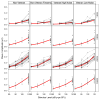Auditory Brainstem Response Altered in Humans With Noise Exposure Despite Normal Outer Hair Cell Function
- PMID: 27992391
- PMCID: PMC5313078
- DOI: 10.1097/AUD.0000000000000370
Auditory Brainstem Response Altered in Humans With Noise Exposure Despite Normal Outer Hair Cell Function
Abstract
Objectives: Recent animal studies demonstrated that cochlear synaptopathy, a partial loss of inner hair cell-auditory nerve fiber synapses, can occur in response to noise exposure without any permanent auditory threshold shift. In animal models, this synaptopathy is associated with a reduction in the amplitude of wave I of the auditory brainstem response (ABR). The goal of this study was to determine whether higher lifetime noise exposure histories in young people with clinically normal pure-tone thresholds are associated with lower ABR wave I amplitudes.
Design: Twenty-nine young military Veterans and 35 non Veterans (19 to 35 years of age) with normal pure-tone thresholds were assigned to 1 of 4 groups based on their self-reported lifetime noise exposure history and Veteran status. Suprathreshold ABR measurements in response to alternating polarity tone bursts were obtained at 1, 3, 4, and 6 kHz with gold foil tiptrode electrodes placed in the ear canal. Wave I amplitude was calculated from the difference in voltage at the positive peak and the voltage at the following negative trough. Distortion product otoacoustic emission input/output functions were collected in each participant at the same four frequencies to assess outer hair cell function.
Results: After controlling for individual differences in sex and distortion product otoacoustic emission amplitude, the groups containing participants with higher reported histories of noise exposure had smaller ABR wave I amplitudes at suprathreshold levels across all four frequencies compared with the groups with less history of noise exposure.
Conclusions: Suprathreshold ABR wave I amplitudes were reduced in Veterans reporting high levels of military noise exposure and in non Veterans reporting any history of firearm use as compared with Veterans and non Veterans with lower levels of reported noise exposure history. The reduction in ABR wave I amplitude in the groups with higher levels of noise exposure cannot be accounted for by sex or variability in outer hair cell function. This change is similar to the decreased ABR wave I amplitudes observed in animal models of noise-induced cochlear synaptopathy. However, without post mortem examination of the temporal bone, no direct conclusions can be drawn concerning the presence of synaptopathy in the study groups with higher noise exposure histories.
Conflict of interest statement
The authors have no conflicts of interest to disclose.
Figures








References
-
- Beach EF, Gilliver M, Williams W. The NOISE (Non-occupational incidents, situations and events) database: A new research tool. Ann Leis Res. 2013;16:149–159.
-
- Berger E. Hearing protection devices. In: Berger E, Royster L, Royster J, et al., editors. The Noise Manual. Fairfax, VA: American Industrial Hygiene Association; 2003. pp. 379–454.
-
- Berger E. Noise Navigator sound level database with over 1700 measurement values. 2015 Retrieved December 2015, from http://multimedia.3m.com/mws/media/888553O/noise-navigator-sound-levelhe....
-
- Bramhall N, Ong B, Ko J, et al. Speech perception ability in noise is correlated with auditory brainstem response wave I amplitude. J Am Acad Audiol. 2015;26:509–517. - PubMed
REFERENCE NOTES
-
- Griest S, Carlson K, Theodoroff S, et al. Documentation of Overall Noise and Solvent Exposures in Recently Separated Military Personnel. Poster session presented at Audiology NOW!; 2015; San Antonio, TX. 2015.

